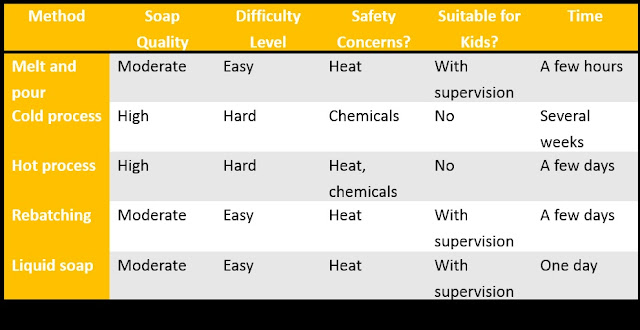Let's start by saying that making soap with the M&P method will allow you to prepare a home-made product that, differently from the commercial soaps, will have a controlled list of ingredients.
This method is suitable for kids (taken for granted that an adult will be around to avoid the poor kids to get burned!)
It doesn't need lye (Sodium Hydroxide) handling and it doesn't require CURING time.
The only disadvantage I see, is that you have a limited number of ingredients you can choose because you start from a pre-existing base.
For this reason you have to be very careful about the base you buy: most of them contain very harsh detergents (SLS) and potentially harmful preservatives (PARABENS).
This method can produce lower soap quality than some other methods.
This is a table I found on LoveToKnow.com, and that lists all the soap-making processes with their pros and cons.
M&P soap is actually a blend of true soap ingredients plus glycerin (great for repairing skin) and molecules like sorbitol and propylene glycol (also used in coffee-based drinks, liquid sweeteners, ice cream, etc.) which allow this kind of soap to melt.
M&P soap is made with lye+natural oils like true soap, but this step is done for you, by the soap base producers, beforehand.
This method is suitable for kids (taken for granted that an adult will be around to avoid the poor kids to get burned!)
It doesn't need lye (Sodium Hydroxide) handling and it doesn't require CURING time.
The only disadvantage I see, is that you have a limited number of ingredients you can choose because you start from a pre-existing base.
For this reason you have to be very careful about the base you buy: most of them contain very harsh detergents (SLS) and potentially harmful preservatives (PARABENS).
This method can produce lower soap quality than some other methods.
This is a table I found on LoveToKnow.com, and that lists all the soap-making processes with their pros and cons.
 |
Credits for the table to:
http://crafts.lovetoknow.com/wiki/Making_Soap
|
Comments
Post a Comment